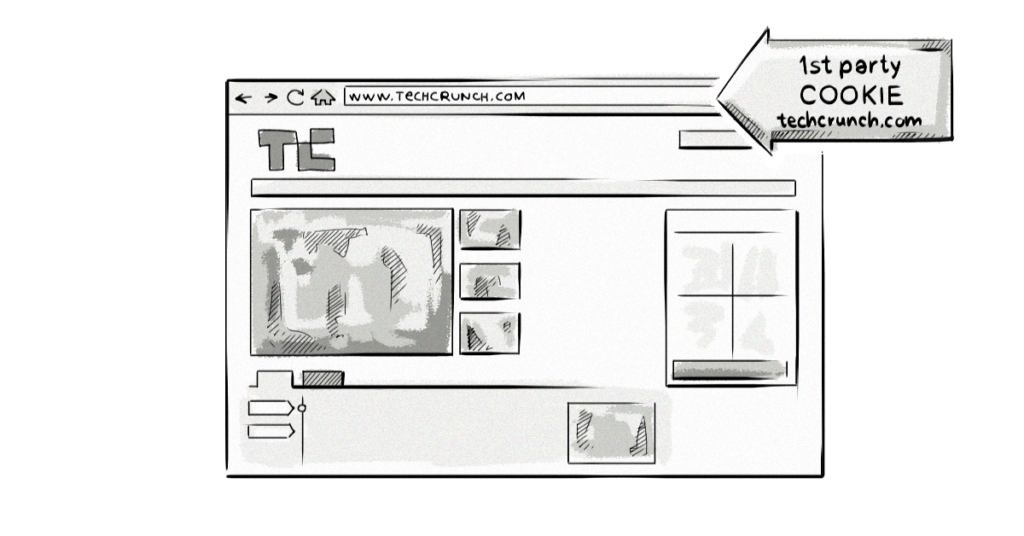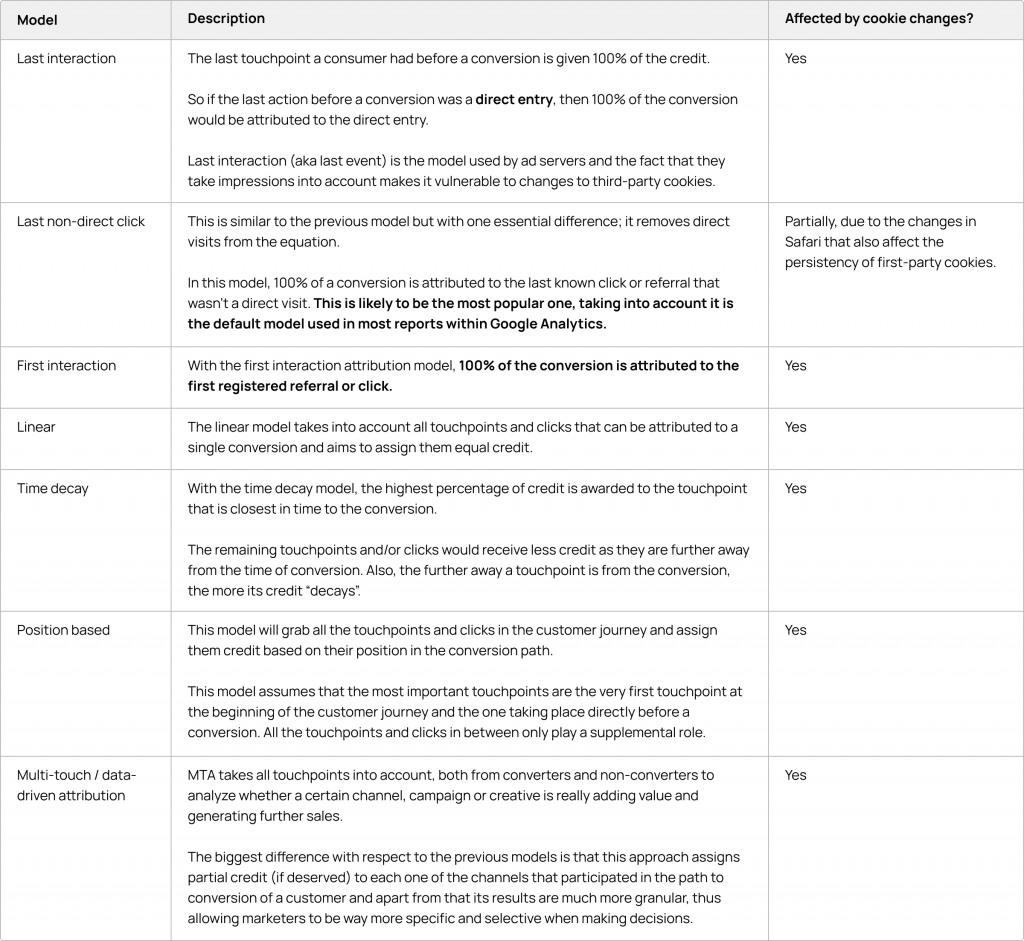Attribution modeling has no future. That’s one of the thoughts people had when Google Chrome announced its plans to shut off support for third-party cookies. The reasoning behind statements like this is pretty simple and it all has to do with the way attribution modeling platforms collect the data.
But is it true?
In this second part of our series about the past, present and future of measurement and attribution modeling, we will address how data is collected and which models will be impacted because of these privacy-related changes.
Before that, we recommend that you read the first article to get the full context of this topic.
That being said, let’s dive into the second part!
The Role Third-Party And First-Party Cookies Play In Attribution
All web cookies are the same; they are files that contain information. In the AdTech and MarTech world, cookies are used to store identifiers. The difference between a third-party cookie and first-party cookie has to do with the domain that created them.
Third-party cookies: In the context of attribution modeling, these allow platforms to collect information from the impressions and clicks generated by ads served from a certain advertiser (or rather, an AdTech platform).
First-party cookies: Are typically used for collecting on-site information and are mainly associated with web analytics.

As we covered in the first part of the series, the recent changes in web browsers are impacting third-party cookies. That means advertisers and marketers no longer have the same data about clicks and impressions they once had, so what does that mean for attribution models?
Let’s have a look at the different types of attribution that are available and the connection to third-party cookies.
How Are Impressions And Clicks Used In Attribution?
Impressions for view-through attribution
View-through attribution aims to measure the impact display ads have on conversions.
It works by firing an impression tag.
Impression tags, which are present in creatives, contain tracking codes that point to ad servers and other platforms. Each time the tag fires, cookies are inserted in the user’s browser. This allows attribution models to assign credit on sales to an impression even if the user has not clicked on the creative.

Here’s the sequence of what needs to happen to get a display ad that was not clicked on to be attributed to a transaction:
- An ad from Basketballshoes.com gets served and viewed on a website (SuperShoes).
- The impression tag fires and informs the ad server and other trackers from other platforms (e.g. attribution platforms) that the impression was loaded.
- The ad server saves a cookie containing an ID to the user’s browser.
- A couple days later, the same user on the same device and browser searches for a pair of basketball shoes.
- The user clicks on the basketball.com link, visits the landing page, and finally purchases the shoes.
- The ad server’s and attribution platform’s conversion pixels fire on the confirmation page. They recognize the cookies they created when the ad was served on SuperShoes, allowing the ad server and attribution platforms to connect that sale to the initial ad.
Click-through attribution
The method for click-through tracking works like this:

Here’s the sequence of what needs to happen for an ad click to be attributed to a transaction:
- An ad from basketballshoes.com gets served and is displayed on a website (SuperShoes).
- The user clicks on the ad.
- The ad server saves a cookie containing an ID to the user’s browser.
- A couple days later, the same user on the same device and browser searches for a pair of basketball shoes.
- The conversion pixel of the AdTech or MarTech platform fires on the confirmation page. The AdTech or MarTech platform is able to attribute the click to the conversion and identify which ad resulted in the conversion because of the cookie ID and click ID.
Multi-touch attribution
In this part, we will specifically focus on Nielsen’s attribution product, which is one of the most complete and agnostic multi-touch attribution (MTA) models on the market.
This form of attribution takes both impressions and clicks into account. Additionally, through server-to-server integrations it also gets data from many other sources that enrich the model, for example, call center sales data, panel data, Facebook data, and many others.
Because of the boom and continuous increase in mobile usage in recent years, MTA focuses heavily on cross-device attribution.
In its more recent Annual Internet Report, Cisco concluded that in 2018 there was an average of 2.8 connected devices per person. This number goes up to 8 devices/pp in countries like the US.
Share of pages served in mobile devices

The growth of mobile devices over the years has contributed to the growth of a multi-device world for consumers.
With stats like these, it’s no wonder why cross-device attribution is one of the key pieces of multi-touch attribution. MTA facilitates the recording of the interactions a user has with a brand across multiple touchpoints and devices, and ultimately attributes conversions to that activity based on algorithms and machine learning (ML) models that take a converter’s and non-converter’s paths into account.
Where the most common attribution models aim to attribute conversions across different channels, multi-touch attribution aims to attribute conversions across different web browsers and devices, as well as channels, campaigns or creatives.
To do this, attribution platforms need to collect IDs and data about the same user across different devices and channels. In web browsers, the most common way to collect user data is by creating third-party cookies and storing an ID inside them.
Here’s an example of how MTA with its cross-device attribution would look:

Nielsen attribution searches the most holistic way of attributing conversions to media activity. Nonetheless, as in previous cases if no alternative is introduced, losing access to third-party data will leave this MTA model with a biased representation of the impact that digital marketing has on conversions and sales.
The Different Attribution Models And The Effect Of The Privacy Fallacy
Fun fact, there are almost as many attribution models as marketing channels, each one of them tends to benefit a specific set of channels.
They vary greatly, but there are two things they all have in common:
- They have been created to help optimize ad spend and digital marketing activation.
- None of them can be considered as the ideal solution. Last non-direct click, for example, happens to be one of the most widely used and most biased at the same time, i.e. it only gives credit to the last non-direct click and doesn’t take into account any other touchpoints a user had in the conversion path.
Below you’ll find a brief summary with the most common attribution models, a few words about how they work, and whether or not they will be affected by the changes to third-party cookies we’ve been talking about.

From this summary there’s an important message we can keep: the only attribution model that won’t see any effect will be pure last click. All other models will experience changes because they all try to stitch the conversion to past activity, which is done with third-party cookies.
Before concluding, let’s run through a quick recap from what we’ve covered so far:
- Popular web browsers like Safari and Firefox have implemented changes to their privacy settings to prevent users from being recognized across different sites (e.g. blocking third-party cookies).
- Google Chrome has also made changes to how it handles third-party cookies (via SameSite) and announced that it will be shutting off support for third-party cookies in the next couple of years. Chrome has also proposed a new way to run targeted advertising and measure and attribution marketing campaigns called Privacy Sandbox.
- “A more private web” is the message behind all these changes, yet it’s unclear whether Google’s AdTech platforms will be impacted in the same way as independent AdTech companies.
- Users don’t get to make decisions anymore on whether they want to accept third-party cookies or not because they are blocked by default in their browser.
- Multi-touch attribution models, DMPs, ad servers, retargeting ads will be affected by the changes to third-party cookies.
- There’s only one attribution model that won’t experience any changes, but it is not the most popular model, which means all marketers will end up seeing their measurement affected in one way or another.
In the next post, we will talk about the future of attribution and how companies are trying to prepare their platforms for a world without third-party cookies.
You can read part 3 of our series here.








